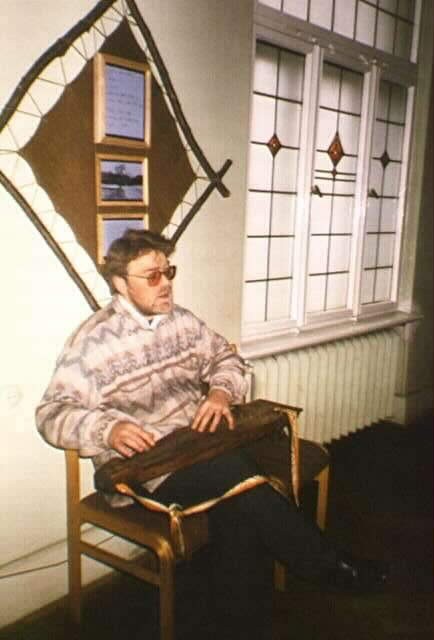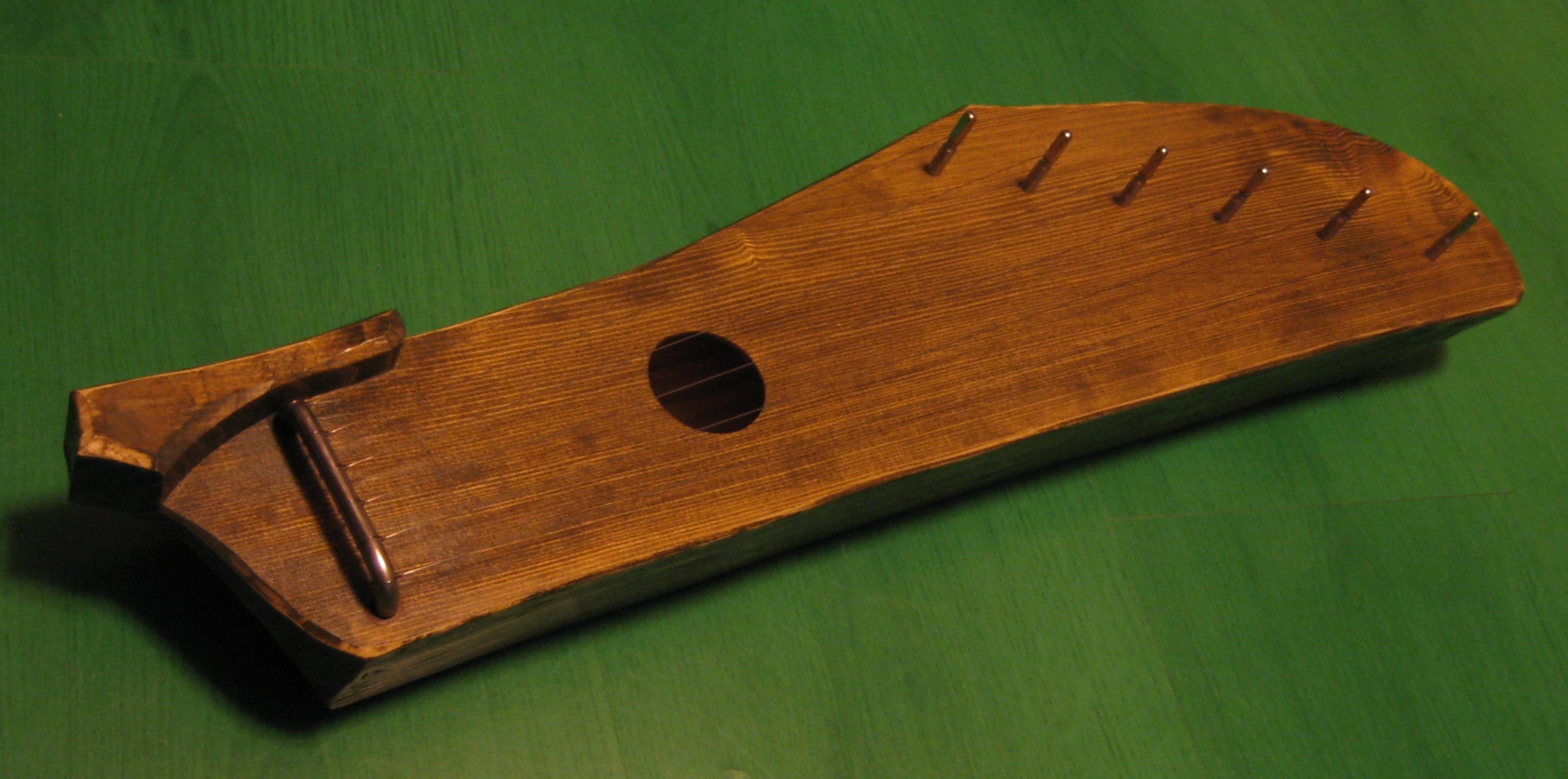|
Kantele
A kantele () or kannel () is a traditional Finnish and Karelian plucked string instrument (chordophone) belonging to the south east Baltic box zither family known as the Baltic psaltery along with Estonian kannel, Latvian kokles, Lithuanian kanklės and Russian gusli. Construction Small kantele Modern instruments with 15 or fewer strings are generally more closely modeled on traditional shapes, and form a category of instrument known as small kantele, in contrast to the modern concert kantele. The oldest forms of kantele have five or six horsehair strings and a wooden body carved from one piece; more modern instruments have metal strings and often a body made from several pieces. The traditional kantele has neither bridge nor nut, the strings run directly from the tuning pegs to a metal bar (''varras'') set into wooden brackets (''ponsi''). Though not acoustically efficient, this construction is part of the distinctive sound of the instrument. The most typical and t ... [...More Info...] [...Related Items...] OR: [Wikipedia] [Google] [Baidu] |
Kokles
Kokle (; ltg, kūkle) or historically kokles (''kūkles'') is a Latvian plucked string instrument (chordophone) belonging to the Baltic box zither family known as the Baltic psaltery along with Lithuanian kanklės, Estonian kannel, Finnish kantele, and Russian krylovidnye gusli. The first possible kokles related archaeological findings in the territory of modern Latvia are from the 13th century, while the first reliable written information about kokles playing comes from the beginning of the 17th century. The first known kokles tune was notated in 1891, but the first kokles recordings into gramophone records and movies were made in 1930s. Both kokles and kokles playing are included in the Latvian Culture Canon. Etymology According to Finnish linguist Eino Nieminen, the name of the instrument, along with the names of most of its neighbouring counterparts (Lithuanian ''kanklės'', Finnish ''kantele'', Estonian ''kannel'' and Livonian ''kāndla''), possibly comes from the pro ... [...More Info...] [...Related Items...] OR: [Wikipedia] [Google] [Baidu] |
Baltic Psaltery
Baltic psaltery is a family of related plucked box zithers, psalteries, historically found in the southeast vicinity of the Baltic Sea and played by the Baltic people, Baltic Finns, Volga Finns and northwestern Russians. Types Baltic psalteries include: * Kanklės (Lithuania) * Kantele (Finland, Karelia and Northwest Russia) * Kannel (Estonia) * Kāndla (Livonian people of Northwest Latvia) * Kokles (Latvia) * Krez (Udmurt people of Central Russia) * Krylovidnye gusli (Northwest Russia) * Kusle (Mari people of Central Russia) * Harpu (Sápmi) The internationally most known instrument of the family is Finnish kantele, so its name is sometimes used in English to also refer to other Baltic psalteries as well. Many of the Baltic psalteries hold a strong symbolic significance in their respective countries, including Finland, Latvia, Lithuania, Estonia and Russia, where playing instruction and instrument makers are available. Etymology According to Finnish linguist Eino ... [...More Info...] [...Related Items...] OR: [Wikipedia] [Google] [Baidu] |
Martti Pokela
Martti Eliel Pokela (23 January 1924 – 23 August 2007) was a Finnish folk musician and composer. Pokela was an expert with the kantele, Finland's national musical instrument. Life and career Pokela and his wife, Marjatta Pokela, were widely credited with ushering in a revival in interest in Finnish folk music beginning in the 1950s. Their daughter, Eveliina Pokela, began performing with them in the 1960s. Pokela merged traditional Finnish folk music with contemporary sounds. The family's albums have also been released outside of Finland. Pokela taught kantele playing at the Sibelius Academy in Helsinki and Kuopio until 1987. He was the founder of the academy's folk music department, where he was named a full professor in 1980. He is buried in the Hietaniemi Cemetery in Helsinki. Albums * Keskiyön Auringon Lauluja (1969) * ''Best of Kantele'' (1995) * ''Sonata For Kantele'' (1996) * ''Snow Kantele'' (1998) * "Tuulikumpu" (2001) * ''Improsette by Martti Pokela'' (2 ... [...More Info...] [...Related Items...] OR: [Wikipedia] [Google] [Baidu] |
Kannel (music)
Kannel () is an Estonian plucked string instrument (chordophone) belonging to the Baltic box zither family known as the Baltic psaltery along with Finnish kantele, Latvian kokles, Lithuanian kanklės, and Russian gusli. The Estonian kannel has a variety of traditional tunings. In Estonia, studying the kannel has made a resurgence after some years of decline. (in ) Etymology According to Finnish linguist , the name of the instrument, along with the names ...[...More Info...] [...Related Items...] OR: [Wikipedia] [Google] [Baidu] |
Gusli
''Gusli'' ( rus, гусли, p=ˈɡuslʲɪ) is the oldest East Slavic multi-string plucked instrument, belonging to the zither family, due to its strings being parallel to its resonance board. Its roots lie in Veliky Novgorod in Novgorodian Rus'. It may have a connection to the Byzantine form of the Greek kithara, which in turn derived from the ancient lyre, or might have been imported from Western and Central Europe during the Middle Ages, when the zither had immense popularity. It has its relatives in Europe and throughout the world: kantele in Finland, kannel in Estonia, kanklės in Lithuania, kokles in Latvia, Zither in Germany, citera in the Czech Republic, psalterium in France and so on... Furthermore, the kanun has been found in Arabic countries, and the autoharp, in the United States. It is also related to such ancient instruments as Chinese gu zheng, which has a thousand-year history, and its Japanese relative koto. A stringed musical instrument called is listed as ... [...More Info...] [...Related Items...] OR: [Wikipedia] [Google] [Baidu] |
Kanklės
Kanklės () is a Lithuanian plucked string instrument (chordophone) belonging to the Baltic box zither family known as the Baltic psaltery, along with the Latvian kokles, Estonian kannel, Finnish kantele, and Russian gusli. Etymology According to Finnish linguist Eino Nieminen, the name of the instrument, along with the names of most of its neighbouring counterparts (Latvian ''kokles'', Finnish ''kantele'', Estonian ''kannel'' and Livonian ''kāndla''), possibly comes from the proto-Baltic form ''*kantlīs''/''*kantlēs'', which originally meant 'the singing tree', most likely deriving from the Proto-Indo-European root ''*qan-'' ('to sing, to sound'; cf. Latin "canto, cantus, canticum", Italian "cantare", French "chanter", English "chant, cantor"). A Lithuanian ethnologist Romualdas Apanavičius believes ''Kanklės'' could be derived from the Proto-European root ''*gan(dh)-'', meaning 'a vessel; a haft (of a sword)', suggesting that it may be related to the Russian wor ... [...More Info...] [...Related Items...] OR: [Wikipedia] [Google] [Baidu] |
Finns
Finns or Finnish people ( fi, suomalaiset, ) are a Baltic Finnic ethnic group native to Finland. Finns are traditionally divided into smaller regional groups that span several countries adjacent to Finland, both those who are native to these countries as well as those who have resettled. Some of these may be classified as separate ethnic groups, rather than subgroups of Finns. These include the Kvens and Forest Finns in Norway, the Tornedalians in Sweden, and the Ingrian Finns in Russia. Finnish, the language spoken by Finns, is closely related to other Balto-Finnic languages, e.g. Estonian and Karelian. The Finnic languages are a subgroup of the larger Uralic family of languages, which also includes Hungarian. These languages are markedly different from most other languages spoken in Europe, which belong to the Indo-European family of languages. Native Finns can also be divided according to dialect into subgroups sometimes called '' heimo'' (lit. ''tribe''), although ... [...More Info...] [...Related Items...] OR: [Wikipedia] [Google] [Baidu] |
Sibelius Academy
The Sibelius Academy ( fi, Taideyliopiston Sibelius-Akatemia, sv, Sibelius-Akademin vid Konstuniversitetet) is part of the University of the Arts Helsinki and a university-level music school which operates in Helsinki and Kuopio, Finland. It also has an adult education centre in Järvenpää and a training centre in Seinäjoki. The Academy is the only music university in Finland. It is among the biggest European music universities with roughly 1,400 enrolled students. The Sibelius Academy is the organizer of thInternational Maj Lind Piano Competitionand one of the organizers of the International Jean Sibelius Violin Competition held every five years in Helsinki. History The academy was founded in 1882 by Martin Wegelius as ' ("Helsinki Music Institute") and renamed ' in 1939 to honour its own former student and Finland's most celebrated composer Jean Sibelius. In 2013, the academy merged with two formerly independent universities, Helsinki Theatre Academy and Academy of Fine ... [...More Info...] [...Related Items...] OR: [Wikipedia] [Google] [Baidu] |
Plucked String Instrument
Plucked string instruments are a subcategory of string instruments that are played by plucking the strings. Plucking is a way of pulling and releasing the string in such a way as to give it an impulse that causes the string to vibrate. Plucking can be done with either a finger or a plectrum. Most plucked string instruments belong to the lute family (such as guitar, bass guitar, mandolin, banjo, balalaika, sitar, pipa, etc.), which generally consist of a resonating body, and a neck; the strings run along the neck and can be stopped at different pitches. The zither family (including the Qanún/kanun, autoharp, kantele, gusli, kannel, kankles, kokles, koto, guqin, gu zheng and many others) does not have a neck, and the strings are stretched across the soundboard. In the harp family (including the lyre), the strings are perpendicular to the soundboard and do not run across it. The harpsichord does not fit any of these categories but is also a plucked string instrument, ... [...More Info...] [...Related Items...] OR: [Wikipedia] [Google] [Baidu] |
Just Intonation
In music, just intonation or pure intonation is the tuning of musical intervals as whole number ratios (such as 3:2 or 4:3) of frequencies. An interval tuned in this way is said to be pure, and is called a just interval. Just intervals (and chords created by combining them) consist of tones from a single harmonic series of an implied fundamental. For example, in the diagram, if the notes G3 and C4 (labelled 3 and 4) are tuned as members of the harmonic series of the lowest C, their frequencies will be 3 and 4 times the fundamental frequency. The interval ratio between C4 and G3 is therefore 4:3, a just fourth. In Western musical practice, instruments are rarely tuned using only pure intervals—the desire for different keys to have identical intervals in Western music makes this impractical. Some instruments of fixed pitch, such as electric pianos, are commonly tuned using equal temperament, in which all intervals other than octaves consist of irrational-number freq ... [...More Info...] [...Related Items...] OR: [Wikipedia] [Google] [Baidu] |
Diatonic
Diatonic and chromatic are terms in music theory that are most often used to characterize scales, and are also applied to musical instruments, intervals, chords, notes, musical styles, and kinds of harmony. They are very often used as a pair, especially when applied to contrasting features of the common practice music of the period 1600–1900. These terms may mean different things in different contexts. Very often, ''diatonic'' refers to musical elements derived from the modes and transpositions of the "white note scale" C–D–E–F–G–A–B. In some usages it includes all forms of heptatonic scale that are in common use in Western music (the major, and all forms of the minor). ''Chromatic'' most often refers to structures derived from the twelve-note chromatic scale, which consists of all semitones. Historically, however, it had other senses, referring in Ancient Greek music theory to a particular tuning of the tetrachord, and to a rhythmic notational conventi ... [...More Info...] [...Related Items...] OR: [Wikipedia] [Google] [Baidu] |






